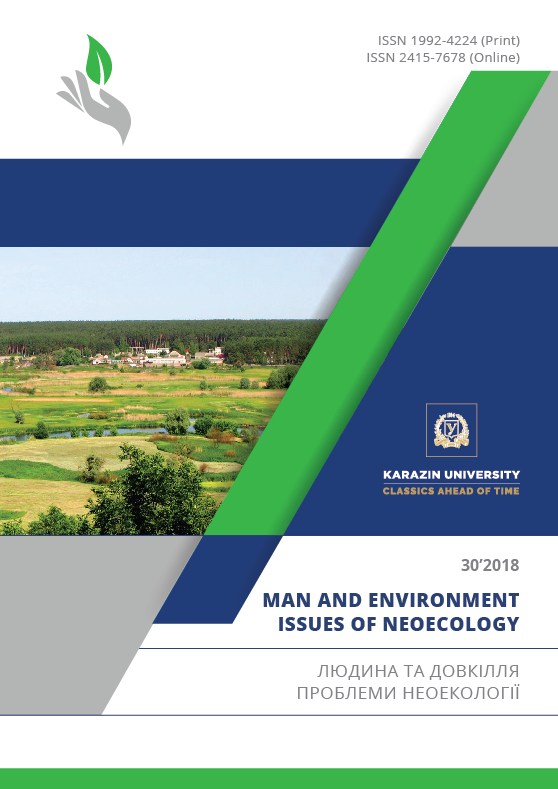Assessment of Environmental Risks From the Air Pollution of China Cities
Abstract
The problem of air pollution in the cities of China is known far beyond its borders. It even jeopardized the holding of the XXIX Olympic Games in 2008. Purpose. o determine environmental risks for the population based on the assessment of air pollution in the cities of Beijing, Chengdu and Sanya (PRC). The work was carried out on the basis of data from the Chinese online platform «PM2.5 lishishuju» on the condition of air pollution in China’s cities. A comparative assessment of pollutants content in the air has been carried out and the environmental risk for the population of these cities has been calculated. This calculation has been made in accordance with the methodology used in assessing the risk to public health exposed to chemicals that pollute the environment by inhaling substances into the human body. The risk is calculated by comparing the actual exposure level with the safe exposure level and determining the hazard coefficient of exposure to the substance. According to the calculations results, the ranking of substances polluting the air by the magnitude of the hazard coefficient was carried out to determine the highest priority pollutants. The results of the study have showed that the overall risk level for Beijing is 11.6; for the city of Chengdu − 26.4; for the city of Sanya − 4.5. In all studied cities, the overall level of non-carcinogenic risk exceeds the permissible limit value. The greatest contribution to the overall risk of non-carcinogenicity is made by the following elements: in Beijing − suspended solids (PM 2.5) − 40%, in Chengdu − suspended solids (PM 2.5) − 73%, in Sanya − ozone (O3) - 52%. These substances determine the likelihood of negative effects in various organs and systems of the human body. Therefore, in addition to the overall level of risk, the effects on critical organs and systems must also be considered. The results of the study have showed that the respiratory organs are most vulnerable to air pollution in the cities under study. The most dangerous excess is observed in Chengdu − 26.11. A negative effect on the cardiovascular system occurs in two cities: Chengdu − 2.35, and Beijing − 2.30; impact on human development is from 2.30 to 2.35 (respectively, in Beijing and Chengdu). In Sanya, risk indicators do not exceed the permissible level.
Downloads
References
Office of Research and Development National Center for Environmental Assessment. Integrated science assessment for oxides of nitrogen (2016), North Carolina United States. [in English].
Paul N. Cheremisinoff, Richard Alan Young (1977). Air Pollution Control and Design Handbook, 672-673 [in English].
Boulter, P G, Borken-Kleefeld, J and Ntziachristos, L (2013). Urban Air Quality in Europe. Handbook of Environmental Chemistry, 31-54 [in English]
Zhao B. (2013) NOx emissions in China: historical trends and future perspectives. Atmospheric Chemistry and Physics, 69- 97 [in English].
Online map of Nitrogen Dioxyde (NO2) in our atmosphere. (2018). Available at: http://aqicn.org/faq/2017-01-10/nitrogen-dioxyde-no2-in-our-atmosphere/ [in English]
World-wide Air Quality Monitoring Data Coverage (2018). doi: http://aqicn.org/sources/ [in English].
United Framework. (2018). Available at: http://aqicn.org/data-platform/register/ [in English]
Air quality monitoring device & sensors research. (2018). Available at: https://aqicn.org/sensor [in English].
Mikroskopicheskaya ugroza: chasticy PM10 i PM2,5 [Microscopic threat: PM10 and PM2.5 particles.] (2107). Available at: https://www.msulab.ru/knowledge/air/microscopic-threat-particles-pm10-and-pm2%265/ [in Russian].
Rukovodstvo po ocenke riska dlya zdorov'ya naseleniya pri vozdejstvii himicheskih veshchestv, zagryaznyayushchih okruzhayushchuyu sredu [Guidelines for assessing the risk to public health when ex-posed to chemicals that pollute the environment ]. (2004). Federal'nyj centr Gossanehpidnadzora Minzdrava Rossii,143 [in Russian].
Air Pollution in Asia: Real-time Air Quality Index Visual Map (2017). Available at: http://aqicn.org/map/
Klіmat m. Pekіna. (2017). Available at: http://bj.weather.com.cn [in Ukrainian].
Klіmat m. Chendu (2017). Available at: http://www.weatherbase.com/weather/ weather.php3?s=49265&refer=&cityname=Chengdu-China [in Ukrainian].
Zagryaznenie vozduha v Pekine v rezhime real'nogo vremeni. Indeks kachestva vozduha (AKI). [Air pollu-tion in Beijing in real time. Air quality index (AQI) ]. (2017). Available at: http://aqicn.org/city/beijing/ru/ [in Russian].
Zagryaznenie vozduha v Chendu v rezhime real'nogo vremeni. Indeks kachestva vozduha (AKI).[ Chengdu Air Pollution Real-Time Air Quality Index (AQI)].(2017). Available at: http://aqicn.org/city/chengdu/ru/ [in Russian].
Klіmat m. San'ya (KNR). (2017). doi: http://www.hnszw.org.cn/data/news/2015/02/76945/ [in Ukrainian].
Zagryaznenie vozduha v San'ya v rezhime real'nogo vremeni. Indeks kachestva vozduha (AKI). (2017). Available at: http://aqicn.org/city/sanya/ru/ [in Russian].
Kіots'kij protokol. [Kyoto Protocol ].(1998). Available at: https://unfccc.int/resource/docs/convkp/kprus.pdf [in Ukrainian].
Maksimenko N. V. (2012) Environmental management activity textbook for students of higher education establishments, Kharkiv, Ukraine, 336 [in Ukrainian].
Authors reserve the right of attribution for the submitted manuscript, while transferring to the Journal the right to publish the article under the Creative Commons Attribution License 4.0 International (CC BY 4.0). This license allows free distribution of the published work under the condition of proper attribution of the original authors and the initial publication source (i.e. the Journal)
Authors have the right to enter into separate agreements for additional non-exclusive distribution of the work in the form it was published in the Journal (such as publishing the article on the institutional website or as a part of a monograph), provided the original publication in this Journal is properly referenced
The Journal allows and encourages online publication of the manuscripts (such as on personal web pages), even when such a manuscript is still under editorial consideration, since it allows for a productive scientific discussion and better citation dynamics (see The Effect of Open Access).





